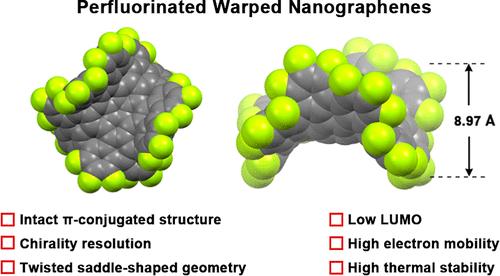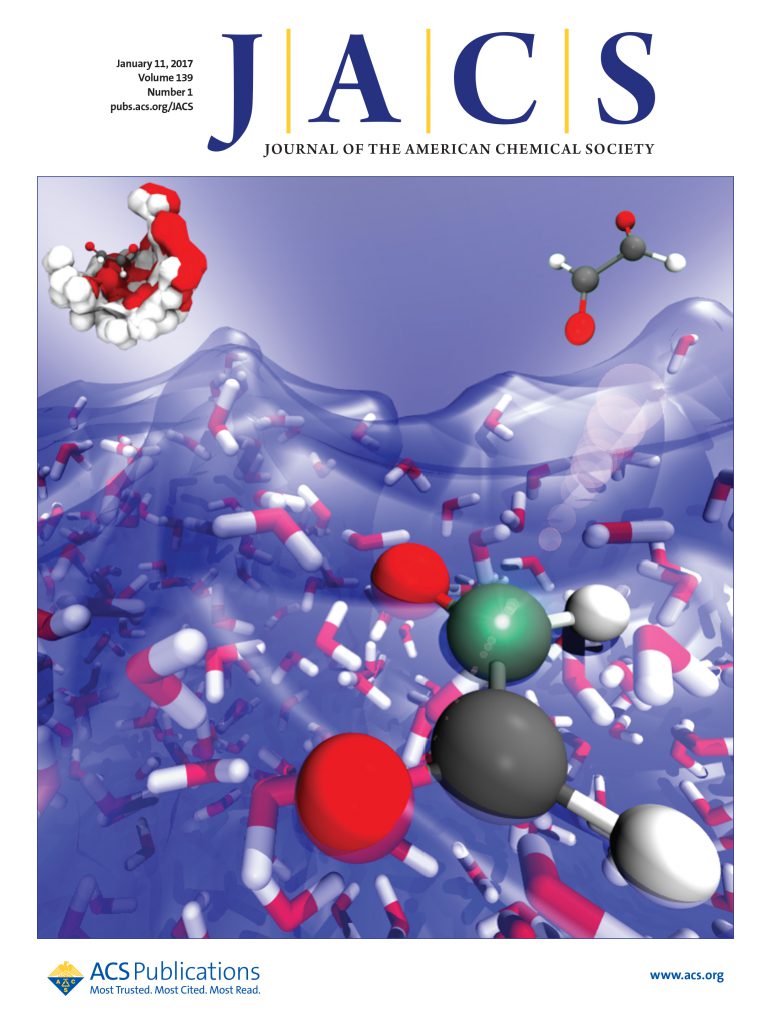脱氟和全氟翘曲纳米石墨:合成、结构分析和特性
IF 14.4
1区 化学
Q1 CHEMISTRY, MULTIDISCIPLINARY
引用次数: 0
摘要
氟化是调整纳米碳材料物理化学特性的有效方法。然而,由于氟化反应的剧烈性,实现纳米石墨烯的边缘全氟化同时保持其原始的 π 共轭结构具有挑战性。在这里,我们没有采用传统的氟化方法,而是采用了一种涉及氟预装的自下而上的策略,通过 10 倍 Suzukii-Miyaura 偶联和苛刻的 Scholl 反应,合成了去氟化和全氟化的翘曲纳米石墨烯(分别为 DFWNG 和 PFWNG),首次实现了具有完整 π 共轭结构的精确边缘全氟化纳米石墨烯。X 射线晶体学证实,与 DFWNG 相比,PFWNG 具有完整的 π 共轭结构和更加扭曲的马鞍形几何形状。动态研究表明,与 DFWNG 和原始 WNG 相比,PFWNG 的 26 环碳框架的柔韧性较低,这使得 PFWNG 的手性解析成为可能,并有助于在 -10 °C 下获得 CD 光谱。PFWNG 的边缘全氟化改善了其溶解性,降低了最低未占用分子轨道,其表面静电势/偶极矩方向与原始 WNG 相反。可能是由于其完整的 π 共轭结构,PFWNG 的电子迁移率与众所周知的 PC61BM 相当。此外,全氟化还提高了热稳定性和疏水性,使 PFWNG 适合用作热稳定性/疏水性 n 型半导体材料。未来,这种氟化策略还可用于合成其他全氟纳米碳材料,如全氟石墨烯纳米带和多孔纳米碳。本文章由计算机程序翻译,如有差异,请以英文原文为准。

Decafluorinated and Perfluorinated Warped Nanographenes: Synthesis, Structural Analysis, and Properties
Fluorination is a useful approach for tailoring the physicochemical properties of nanocarbon materials. However, owing to the violent reactivity of fluorination, achieving edge-perfluorination of nanographene while maintaining its original π-conjugated structure is challenging. Instead of using traditional fluorination, here, we employed a bottom-up strategy involving fluorine preinstallation and synthesized decafluorinated and perfluorinated warped nanographenes (DFWNG and PFWNG, respectively) through a 10-fold Suzuki–Miyaura coupling followed by a harsh Scholl reaction, whereby precisely edge-perfluorinated nanographene with an intact π-conjugated structure was achieved for the first time. X-ray crystallography confirmed the intact π-conjugated structure and more twisted saddle-shaped geometry of PFWNG compared to that of DFWNG. Dynamic study revealed that the 26-ring carbon framework of PFWNG is less flexible than that of DFWNG and the pristine WNG, enabling chirality resolution of PFWNG and facilitating the achievement of CD spectra at −10 °C. The edge-perfluorination of PFWNG resulted in improved solubility, lower lowest unoccupied molecular orbital, and a surface electrostatic potentials/dipole moment direction opposite those of the pristine WNG. Likely owing to its intact π-conjugated structure, PFWNG exhibits comparable electron mobility with well-known PC61BM. Furthermore, perfluorination improves thermal stability and hydrophobicity, making PFWNG suitable for use as a thermostable/hydrophobic n-type semiconductor material. In the future, this fluorination strategy can be used to synthesize other perfluorinated nanocarbon materials, such as perfluorinated graphene nanoribbons and porous nanocarbon.
求助全文
通过发布文献求助,成功后即可免费获取论文全文。
去求助
来源期刊
CiteScore
24.40
自引率
6.00%
发文量
2398
审稿时长
1.6 months
期刊介绍:
The flagship journal of the American Chemical Society, known as the Journal of the American Chemical Society (JACS), has been a prestigious publication since its establishment in 1879. It holds a preeminent position in the field of chemistry and related interdisciplinary sciences. JACS is committed to disseminating cutting-edge research papers, covering a wide range of topics, and encompasses approximately 19,000 pages of Articles, Communications, and Perspectives annually. With a weekly publication frequency, JACS plays a vital role in advancing the field of chemistry by providing essential research.

 求助内容:
求助内容: 应助结果提醒方式:
应助结果提醒方式:


